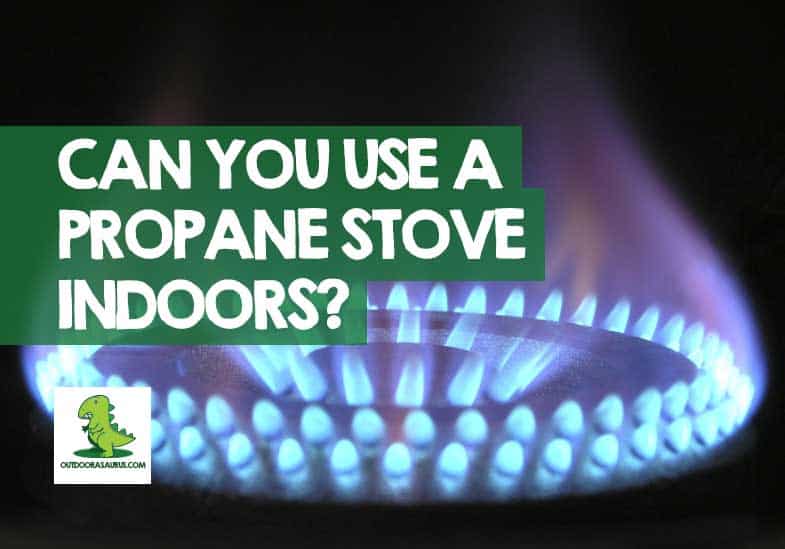Before you get too deep into this article, I want to place a large disclaimer: I do not recommend that you use a propane stove indoors at any given point in time. It can be dangerous, but most people do it safely with no problems. I am not recommending you take this advice literally, and use it for informational purposes only.
Can you use a propane stove indoors? Yes you can use a propane stove indoors. However, it could be unsafe due to the way that gas can build-up. If you do decide to use a propane stove indoors, please do so in well-ventilated area, turn off after use, and cook near an open window.
That’s the answer in short, and here’s a comment I read on Reddit which I think sums up whether or not it’s safe to use a propane stove indoors:
“You can use a propane stove indoors, but you shouldn’t. As the propane gas is burned, it releases the heat that cooks your food, but also deadly carbon monoxide. A camp stove and a propane grill both produce this gas, but the grill will produce a higher volume faster. So, both could kill you, but a propane grill is more likely to kill you.”
Using a propane stove indoors
Just in case you don’t have the luxury of time to go through the whole length of this article, here is a piece of essential information for you: yes, you can use a propane stove indoors but it’s not advisable.
Propane is a common gas fuel used in stoves and cookers, both in kitchens and outdoors for camping. It is a popular choice, since it doesn’t have the smell of kerosene, more environmentally friendly, because it burns cleanly, and compared to other alternatives, is relatively inexpensive.
Propane or LPG (Liquefied Petroleum Gas) as it is sometimes known, is a gas that is typically compressed and stored as a liquid in airtight tanks. It is a nontoxic, colorless, and almost odorless gas, the apparent scent you get when in a gas station makes it easy to identify and detect it.
Propane is employed commonly for space (house fitted heaters) and water heating, for cooking. And sometimes as fuel for engine usage in equipment like forklifts, farm irrigation engines, buses, and fleet vehicles.
These days though, its applications are growing, as new opportunities to explore more sustainable energy sources present themselves through new technology developments.
When you use it to fuel your automobiles, propane is tagged to be propane Autogas.
Now, from here on, we’ll be exploring why propane stoves are safe indoors. It’ll nice to know a few things about the gas on which the furnace in this post is all about.
Advantages of using a propane-based stove indoors
1. Easy Installation, transportation, and storage
In contrast to other equally popular pyro stoves, propane is a perfect choice for a house kitchen. Other alternatives like Kerosine or Methane (natural gas) have a myriad of disadvantages, one of them being the option of storage.
Natural gas cannot be stored in homes and is only accessible through gas lines, which are not available in every neighborhood. Moreover, the cost implications of running a pipe to your home are very high, and sometimes, it is impossible.
For kerosene, it is hazardous to keep large amounts in your home, because of the possibility of small fires escalated to a wholly burnt house. Besides that, the smell of kerosene is not a friendly one and can cause discomfort.
2. Safety
Compared to other fuels, propane is relatively safe, and even with its volatile nature, it is still not as flammable as other gases. Stoves that use Propane are much less hazardous compared to natural gas stoves, or liquid kerosene.
The fact that it comes from a pressurized tank which can be well controlled by a valve makes it more secure and reduces the risk of spillage and possible explosions. Since methane gas from gas lines has a central control, it is hard for users to control leaks.
In some cases, kerosene has been seen to explode from burning through the clothing or wicks, down into the chamber where the first liquid is stored. This case is rare, but still a possibility.
Propane is also less volatile than the other alternatives and is less likely to burn first.
3. Environmentally Friendly
Propane is considered to be a “green” gas and is way better for consumption as regards the environment. It is listed as a clean fuel and has been on the list since the 1990 Clean Air Act. It is not in any way harmful to the natural environment around it. Benign to soil and water. On the other hand, methane, and kerosene, the two most common alternatives, end up producing harmful fumes and can damage the environment even in their unused state when they come in contact.
Propane burns cleanly do not smell and produce a little amount of carbon monoxide compared to other alternatives.
It is also worthy of note that propane stoves are long-lasting.
4. Time Efficient
Propane flames can produce temperatures up to 3,614o which is way higher than that of kerosene and natural gas. Because of this, it takes less time to reach the desired temperature required by the user.
This time factor might not be a big deal, but over time, these little seemingly small minutes add up to productive time saved for focusing on other tasks.
Safe practices on using a propane stove
Even as we’ve seen the advantages of using a propane stove over other possible choices, it would be wise to try as much as we can to eliminate the few possible deficiencies that arise from using a propane stove indoor.
Some of these ideas below might help:
- Some stoves are for indoor usage. It is easy to overlook this, seeing as sometimes, both outdoor and indoor ovens have the same build. However, it is essential to adhere to the rules and directions provided by the manufacturer.
- Never use a camping stove indoors. Have excellent ventilation to help take care of the residual carbon monoxide produced from combustion. The amount produced might be small, but it is crucial to make it a habit to flush out this toxic gas with fresh air. Providing proper ventilation takes care of that.
- If the flame looks weak (lifting away from the burner) or active (large and yellow), usually, that’s a sign that the stove is malfunctioning. You might also notice some soot on the pots.
- Be sure to keep the propane tank far away from the burner, as proximity can lead to explosions in very extended use. Also, keep the stove or cooker far away from any refrigerating appliances, because of the possibility of them housing propane-based coolants.
As with everything else, there will always be an argument against, and in support of it. The goal is to observe the pros and cons of both sides and weigh all the factors connected to the subject matter.
For example, while kerosene is cheaper than natural gas, it is not as healthy as propane gas, or as effective. For smaller portions and durations, kerosene might come in handy, as it is available in smaller quantities compared to propane, but the end goal is not a one time use, but over an extended period, which makes a massive case for Propane stoves when you look at the bigger picture.
Instead of all arguments presented, it is apparent that propane stoves are usable indoors. Even with the possible hiccups, for which we have outlined solutions and workable actions above, propane cookers remain the most practical choice for in house cookers.
Their benefits far outweigh the other non-propane-based stoves.
Origin
In 1857, Marcellin Berthelot, a French chemist, and a politician discovered Propane, and this was the first time the gas got identified and named. He managed to synthesize many organic compounds from inorganic compounds in his lifetime, disproving Jons Jakob Berzelius’s theory that organic compounds synthesized with the aid of organisms.
Propane is a processed product from domestic natural gas. Also, it is a product of crude oil refining in small quantity. These are the two methods employed in producing propane.
Propane comes from nature, and as a fossil fuel, it does not occur in isolation. It is always in combination with other hydrocarbons.
Pressurization is used to liquefy propane, a process that involves compressing and confining the produced gas in a sealed container; this facilitates its easy transportation.
Applications and uses
Propane is the most commonly used gas for barbecues and portable stoves; this is because of its low boiling point (-42oC) makes it vaporize as soon as it leaves its pressurized container.
As previously stated, buses, forklifts, outboard motors, and taxies and a host of other engines make use of propane. Sometimes, it is used as a turbocharger, in locomotive diesel engines because it yields much better combustion.
Propane is an alternative for refrigerants, aerosol propellants and also as a petrochemical feedstock.
As seen from examples above, because of its high volatile and combustible properties, propane is usable with activities that involve burning and fire. It is no surprise at all that it is an alternative for cooking gas.
But this wasn’t just a simple decision as you would come to see. A lot of other things got considered before adopting propane as a household cooking gas.

